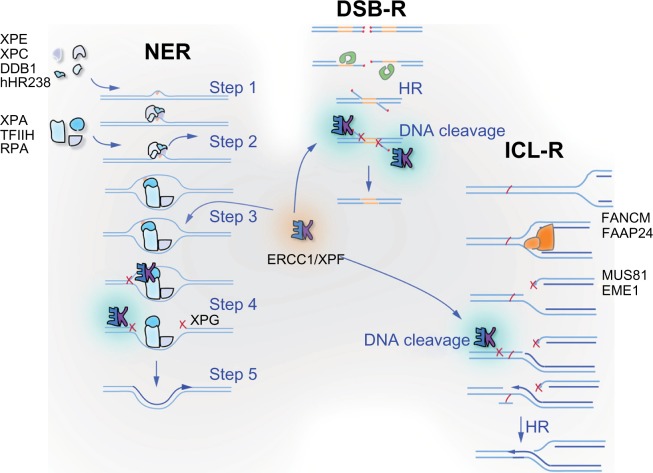Figure 1.
ERCC1 and its obligate binding partner XPF are involved in multiple DNA repair pathways. ERCC1-XPF heterodimer is an endonuclease that cuts one strand of DNA at a double-strand:single-strand junction. It is critical for nucleotide excision repair (NER) of bulky chemical DNA adducts like cisplatin intrastrand crosslinks, the repair of double-strand breaks that cannot be directly ligated back together like those induced by ionizing radiation, and the repair of interstrand crosslinks (ICLs). In NER (represented on the left), adducts that cause distortion of the DNA double helix are detected by XPC-hHR23B, in some cases with the assistance of XPE-DDB1 (Step 1). These complexes recruit of TFIIH, which unwinds the DNA around the adduct and XPA and RPA, which stabilize the open complex (Step 2). XPA recruits ERCC1-XPF to cut the damaged strand 5′ to the adduct (Step 3), while TFIIH recruits a second endonuclease XPG to cut 3′ of the lesion (Step 4). The damaged base is removed as part of a single-stranded oligonucleotide. The replication machinery uses the 3′-OH created by ERCC1-XPF incision to prime DNA synthesis to fill the gap (Step 5). After ligation, the integrity of the DNA is fully restored. In double-strand breaks (DSB) repair (represented in the middle), two broken ends can be spliced together if they have long patches of sequence homology via homologous recombination (labeled HR) or if they have small patches of homology, known as microhomology, very close to the broken ends via alternative end-joining. In both cases, ERCC1-XPF is needed to remove 3′ single-stranded flaps of non-homologous sequence at the ends of the breaks (labeled DNA cleavage) to allow sealing of the spliced ends by a DNA ligase. ICLs (represented on the right) are predominantly repaired during S phase of the cell cycle. ICLs are an absolute block to replication and when encountered by the replication machinery lead to the collapse of the replication fork and creation of a DSB. This DSB cannot be repaired until ERCC1-XPF cuts near the ICL to release it from one strand (DNA cleavage), allowing bypass of the adduct by a translesion polymerase such as REV1/Polζ.

